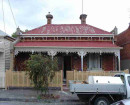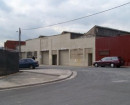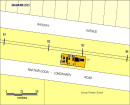Back to search results
MELBOURNE AIDS MEMORIAL QUILT
31-51 COMMERCIAL ROAD, SOUTH YARRA,STONNINGTON CITY
MELBOURNE AIDS MEMORIAL QUILT
31-51 COMMERCIAL ROAD, SOUTH YARRA,STONNINGTON CITY
All information on this page is maintained by Heritage Victoria.
Click below for their website and contact details.
Victorian Heritage Register
-
Add to tour
You must log in to do that.
-
Share
-
Shortlist place
You must log in to do that.
- Download report

Victorian AIDS Memorial Quilt Block B018

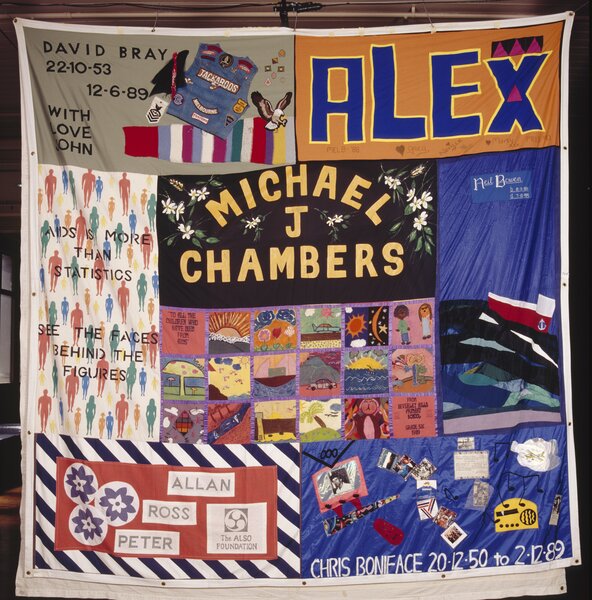
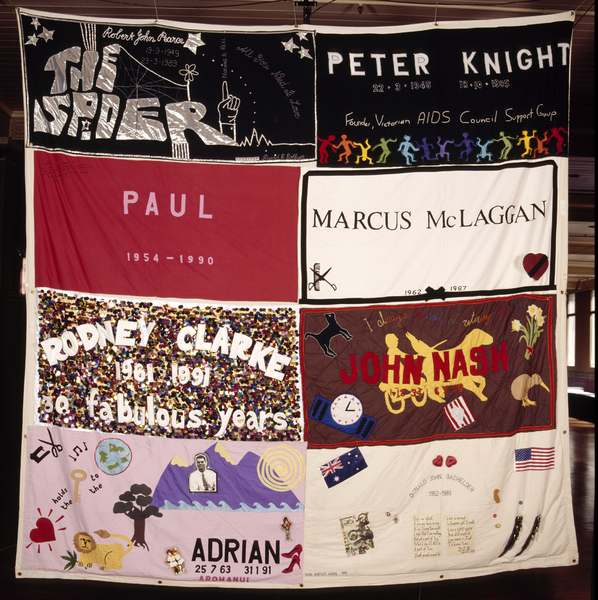
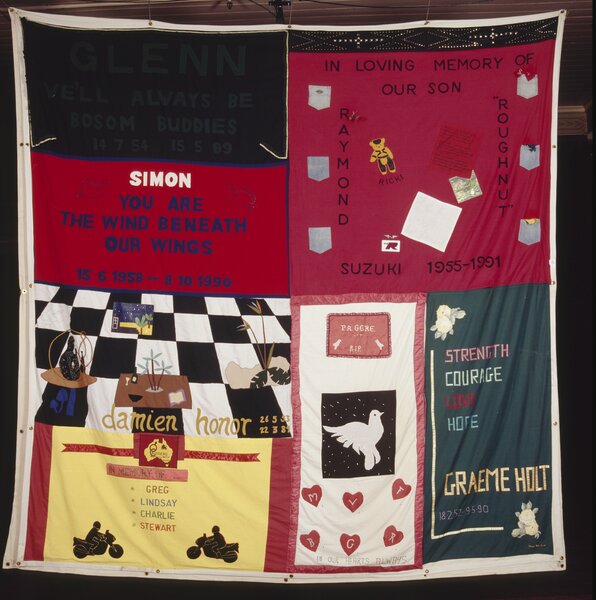
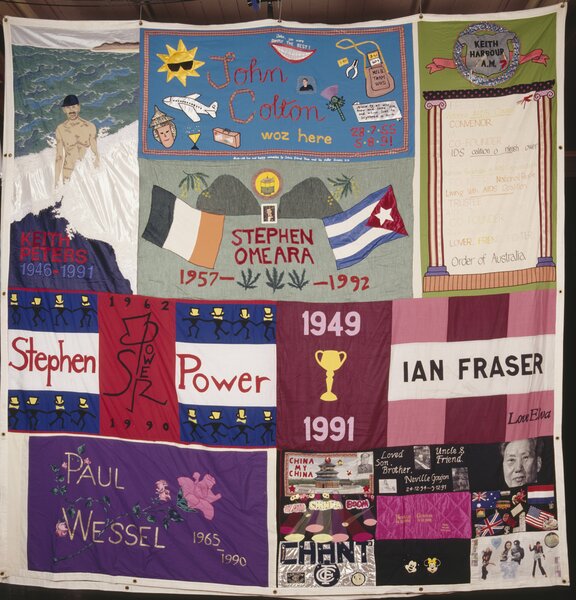

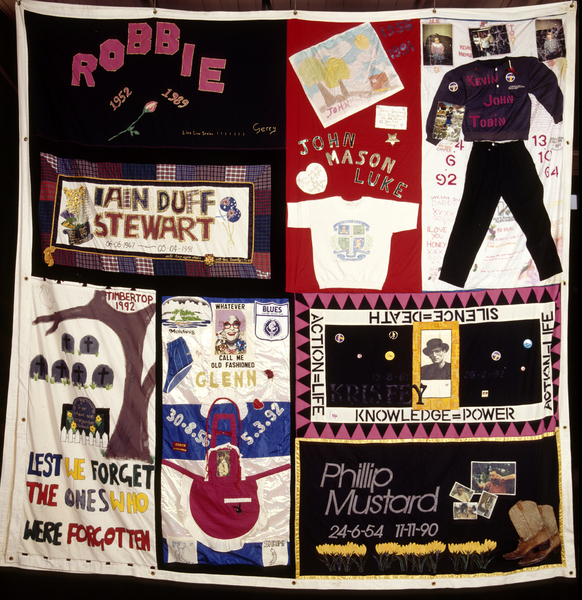
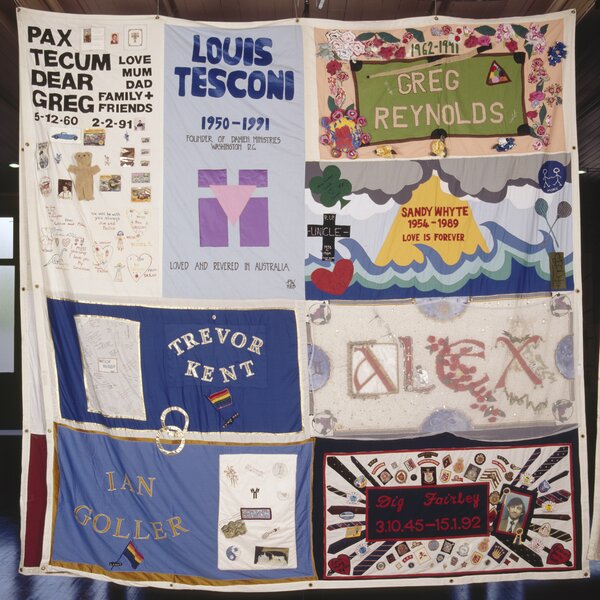

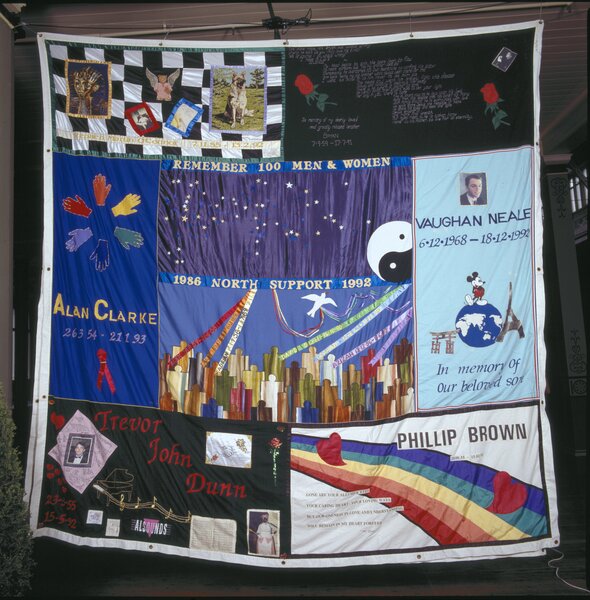
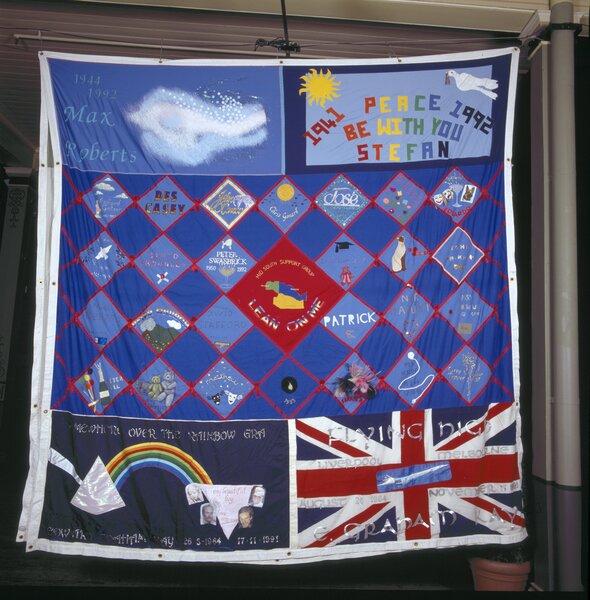
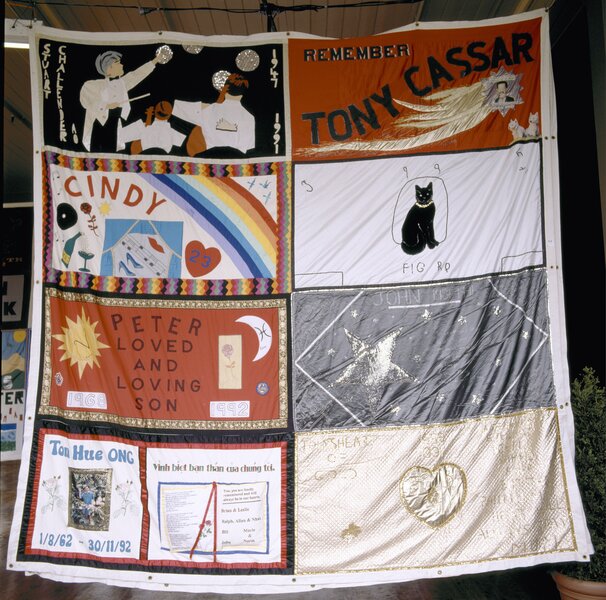
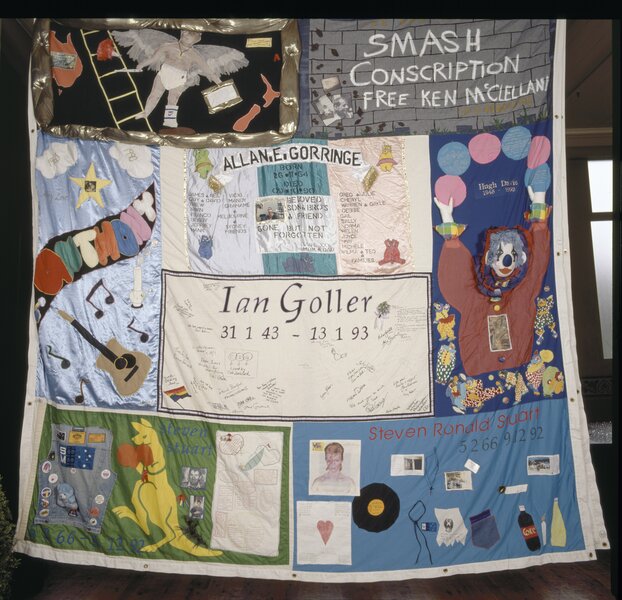
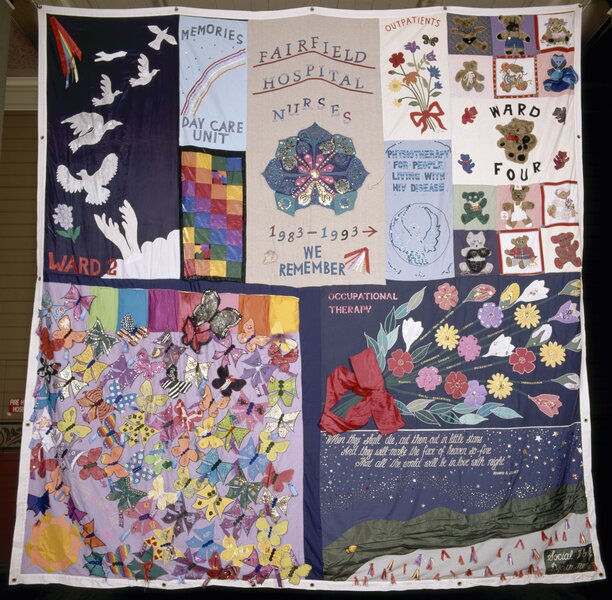
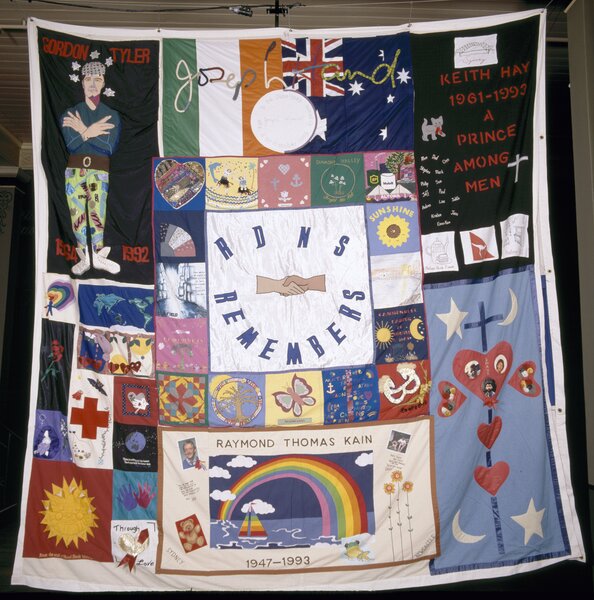
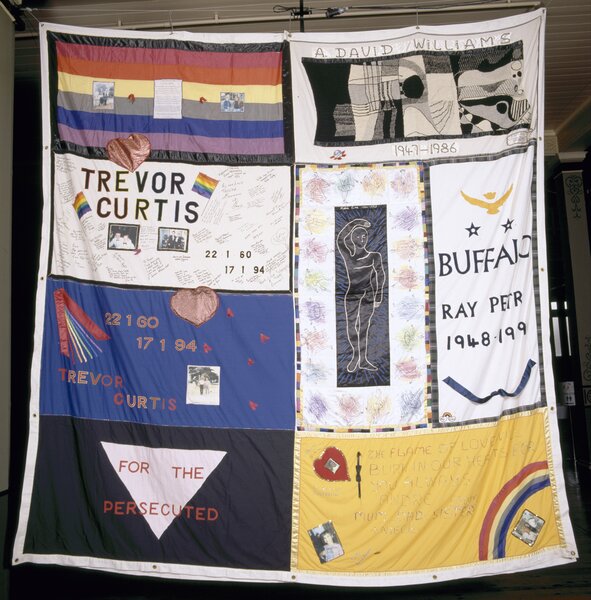
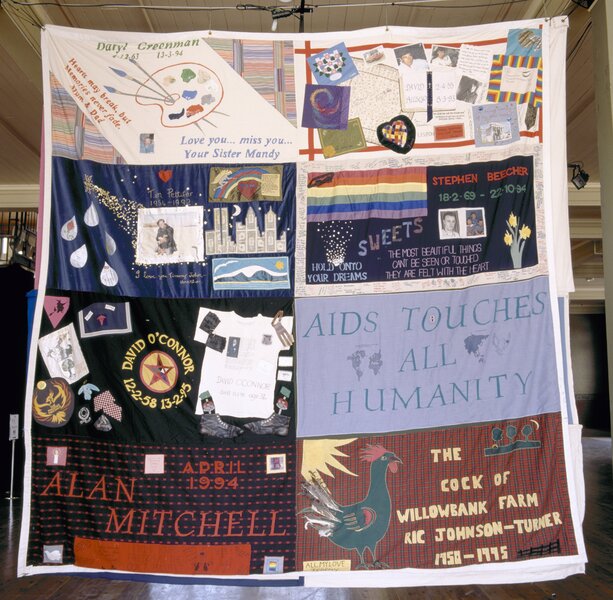
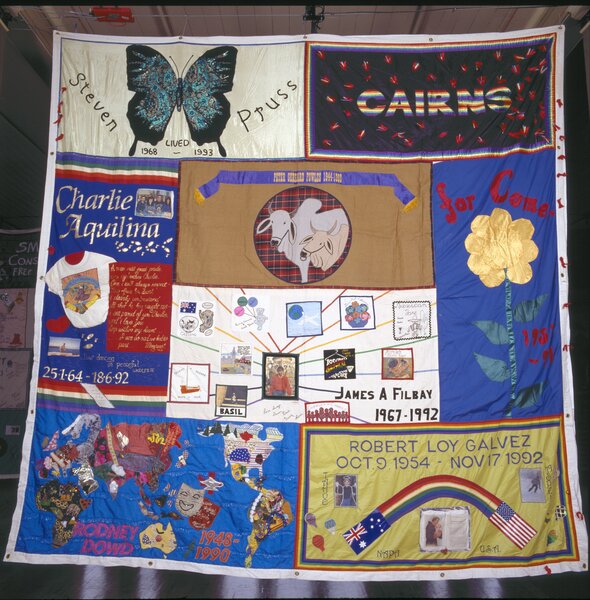
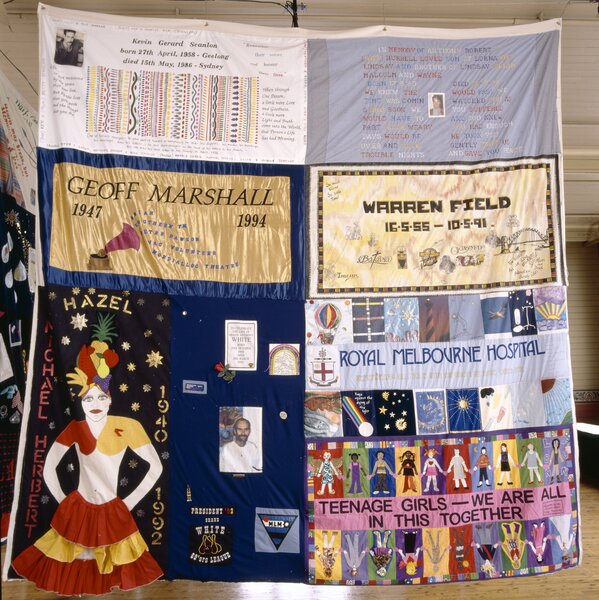
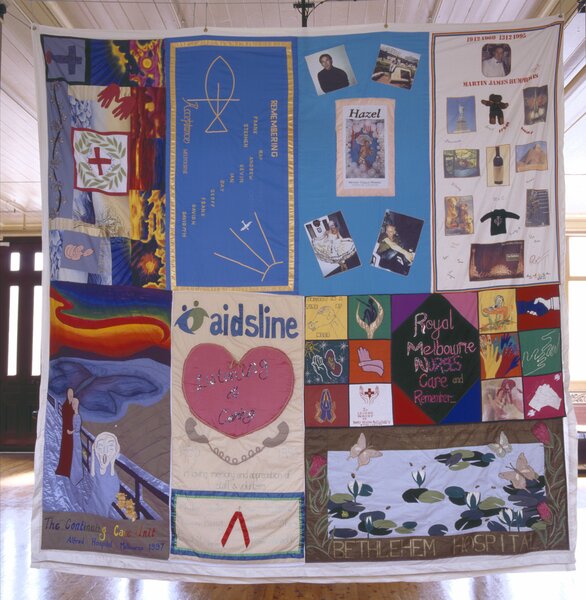
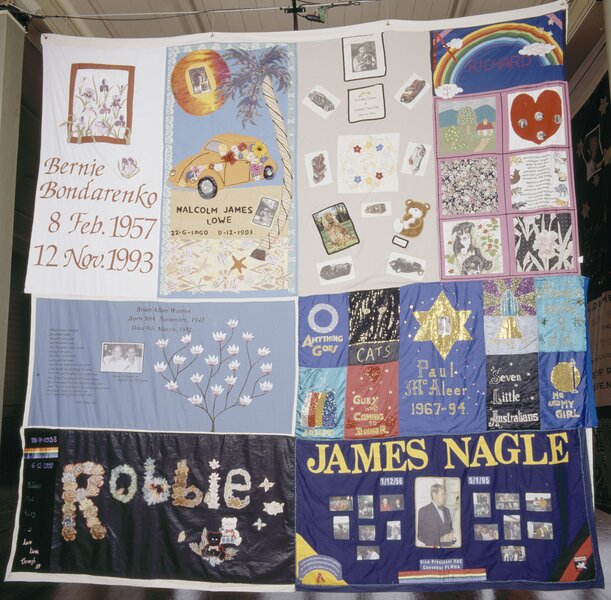
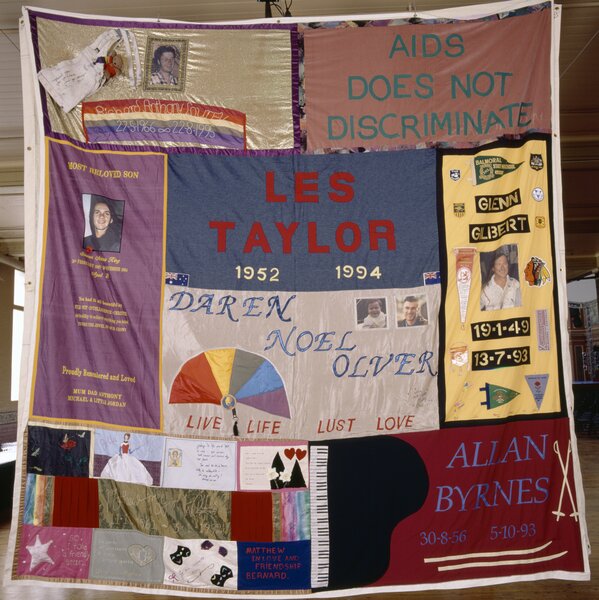

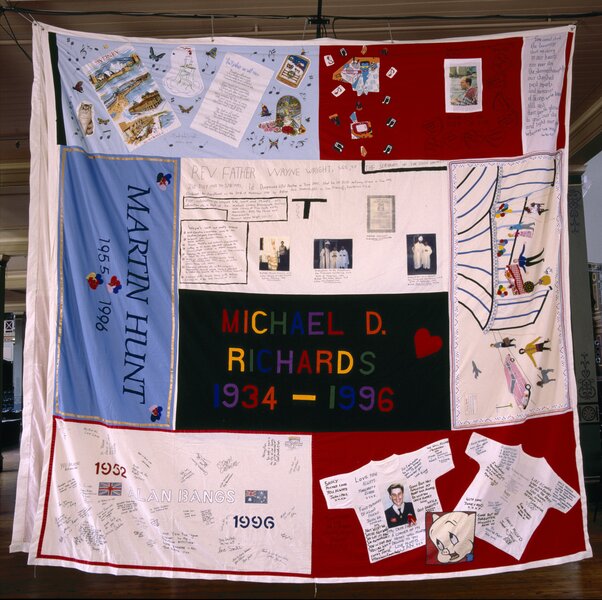
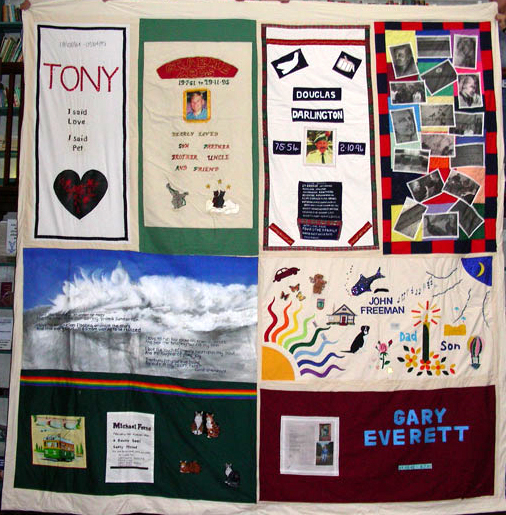


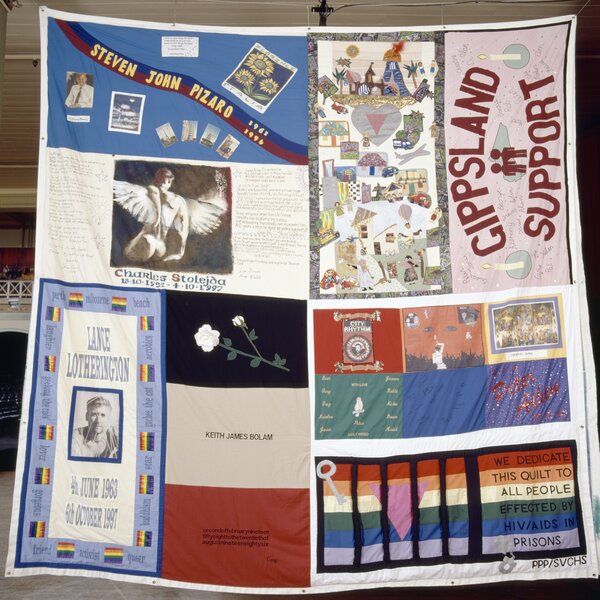
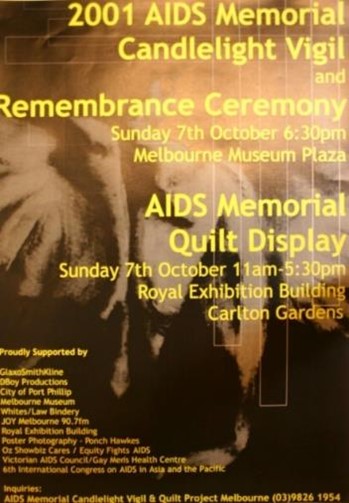
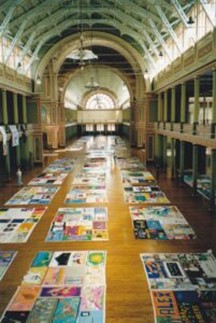
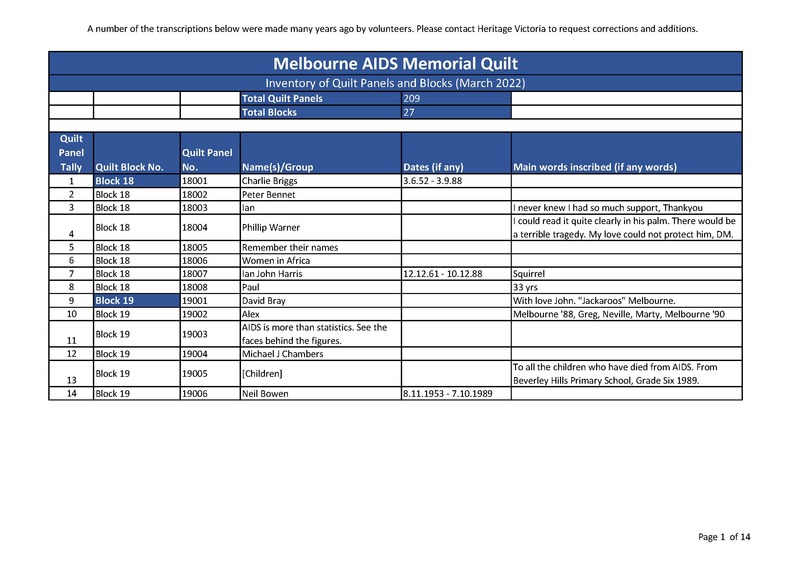
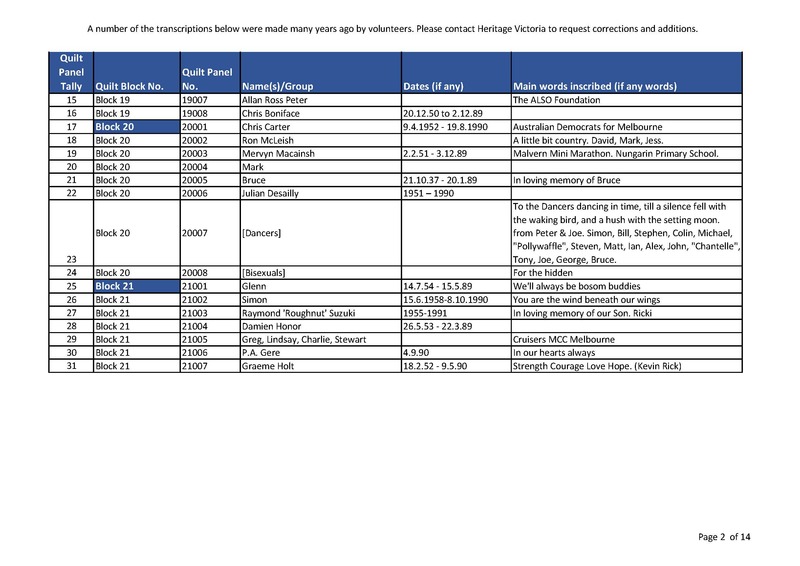
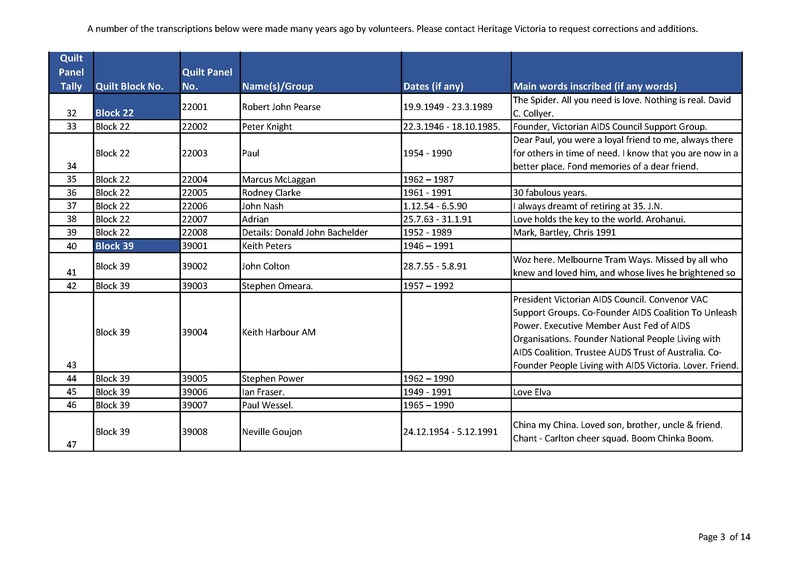

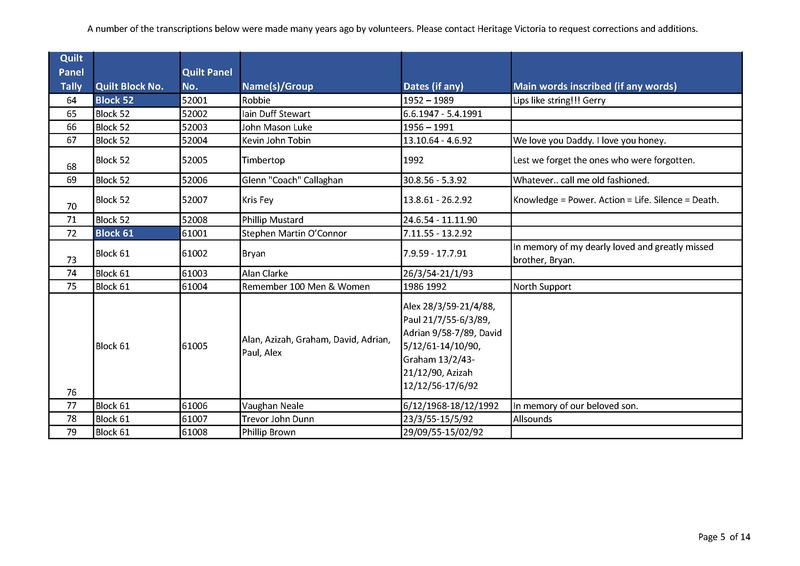
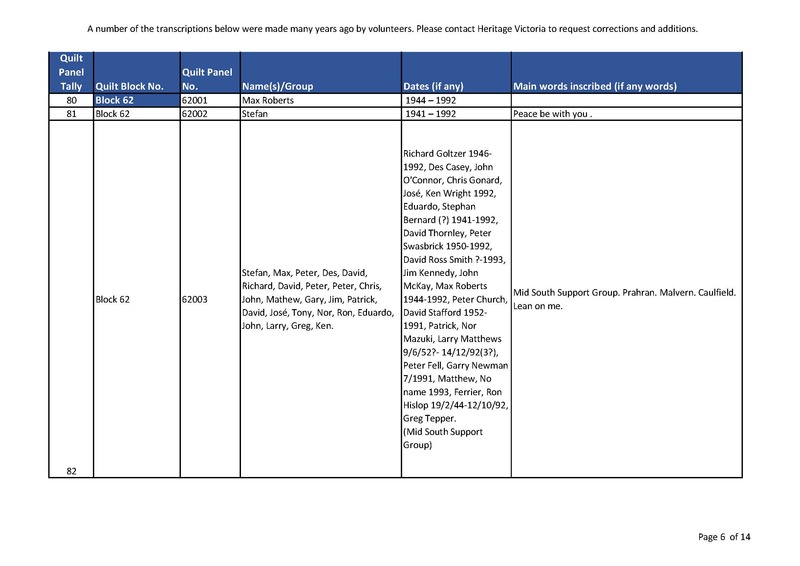
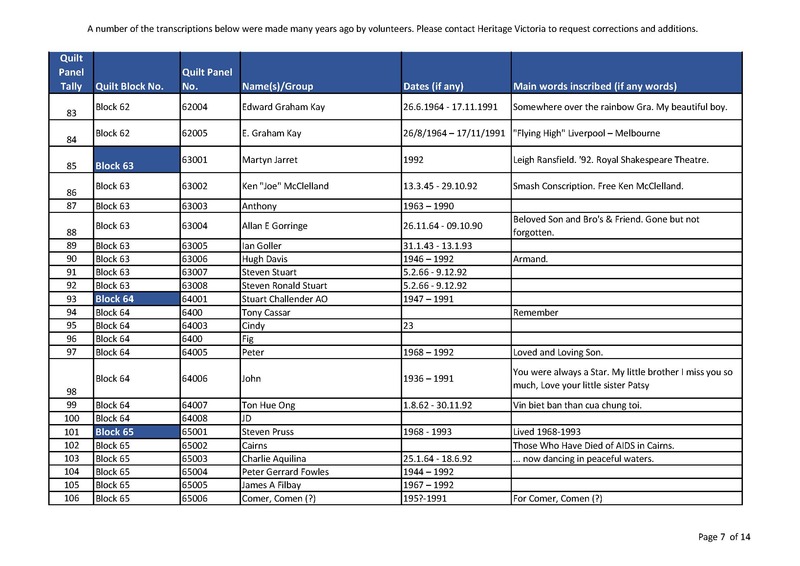
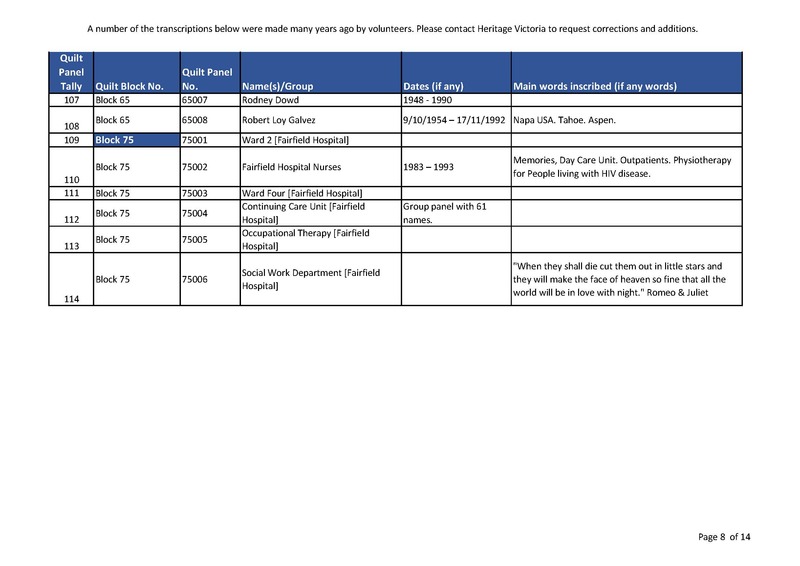
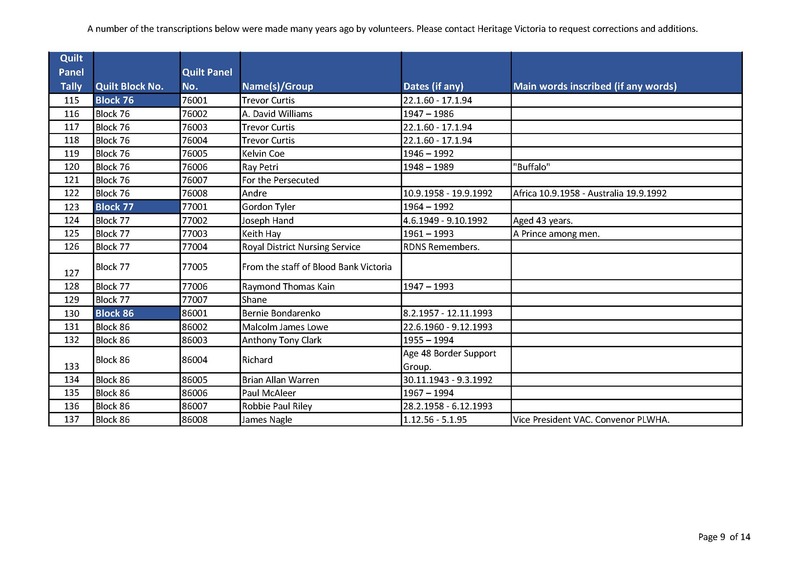
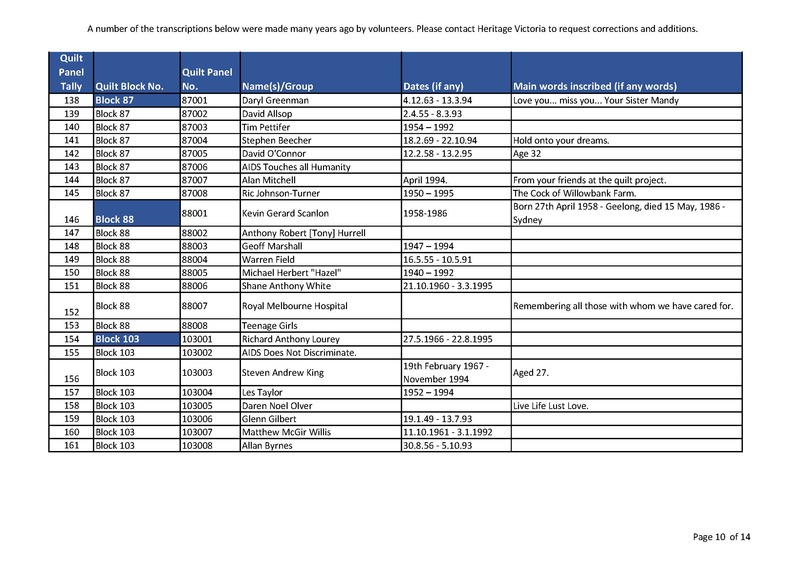

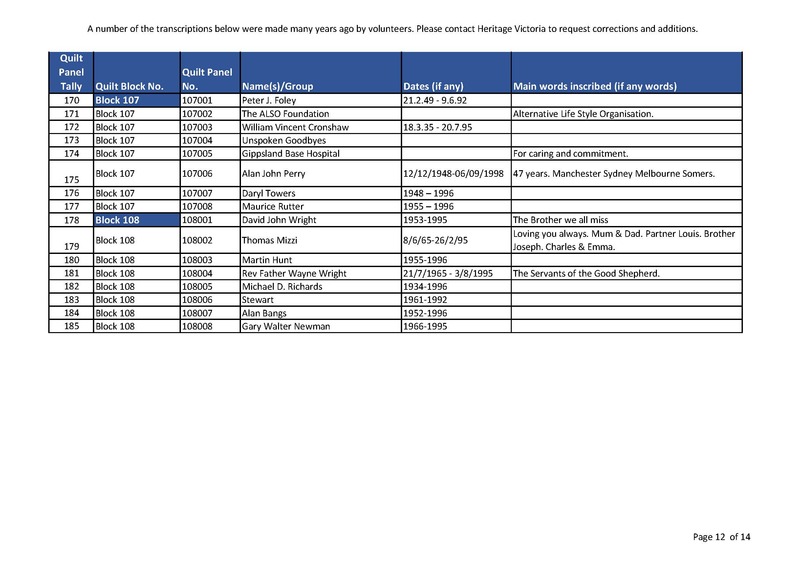
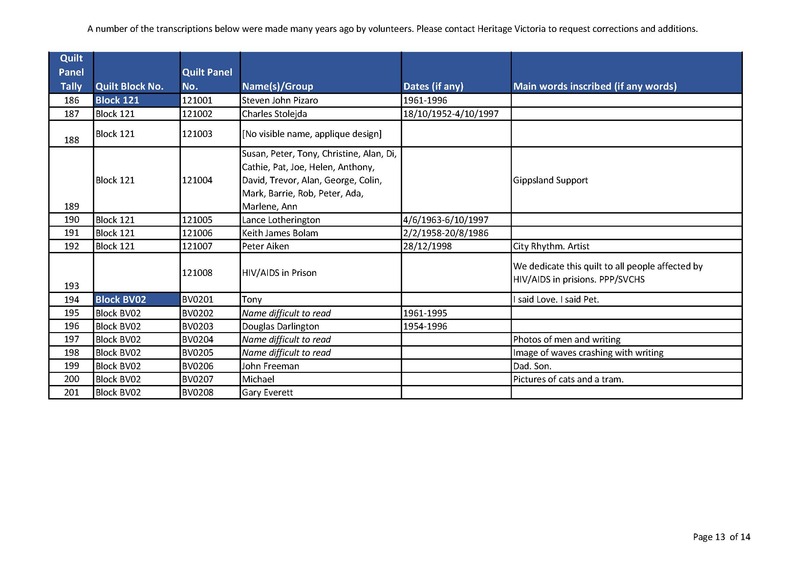
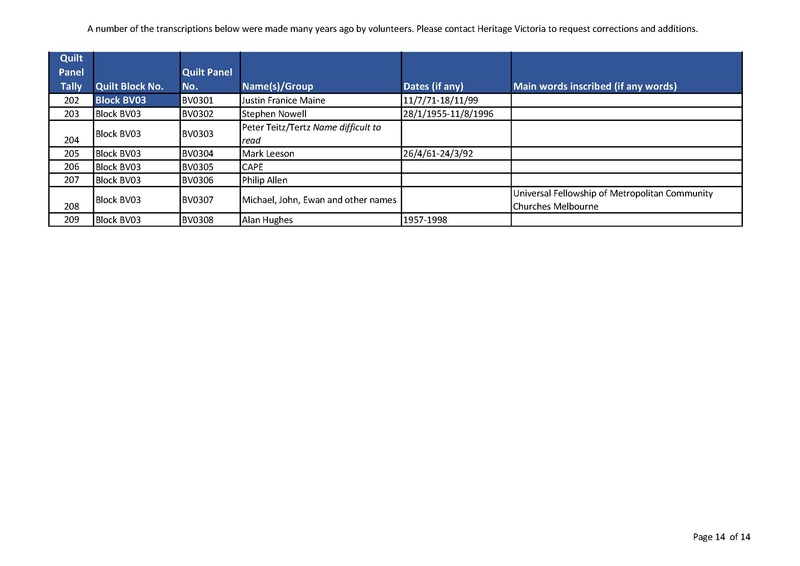
On this page:
Statement of Significance
Melbourne AIDS Memorial Quilt is located on Bunurong Country.
What is significant?
The Melbourne AIDS Memorial Quilt consisting of 209 quilt panels (sewn onto 27 fabric backing blocks typically in groups of eight) each made by a family member or volunteer from 1988 onwards to commemorate a person or group who died from an AIDS-related condition.
How is it significant?
The Melbourne AIDS Memorial Quilt is of historical and social significance to the State of Victoria. It satisfies the following criteria for inclusion in the Victorian Heritage Register:
Criterion A
Importance to the course, or pattern, of Victoria's cultural history.
Criterion D
Importance in demonstrating the principal characteristics of a class of cultural places and objects.
Criterion G
Strong or special association with a particular present-day community or cultural group for social, cultural or spiritual reasons.
Criterion H
Special association with the life or works of a person, or group of persons, of importance in Victoria’s history.
Why is it significant?
The Melbourne AIDS Memorial Quilt is historically significant as one of the most important artefacts of the AIDS crisis in Victoria. Each quilt panel represents a person who died from an AIDS-related condition and had an association to Melbourne or Victoria. Originally coordinated by volunteers working from the Fairfield Hospital from late 1988, each quilt was made by family members, loved ones or volunteers working within community groups, and is highly individualised to commemorate the life of the person. The Melbourne AIDS Memorial Quilt represents the community care, volunteerism and political activism associated with the AIDS crisis.
(Criterion A)
The Melbourne AIDS Memorial Quilt is one of Victoria’s largest, most important and enduring pieces of community art. Part of the international AIDS memorial quilt movement, it represents a pivotal moment in the history of commemorative textile making in Victoria. It powerfully harnesses and transforms the centuries-old western tradition of quilt making – typically a woman’s artform – to allow thousands of people to express their collective grief and mourn together, particularly on World AIDS Day. The quilt is both highly personal and deeply political, and demonstrates the human dimensions of one of the late twentieth century’s most devastating epidemics
(Criterion D)
The Melbourne AIDS Memorial Quilt is iconic in Victoria and has a strong, special, and continuing association with particular social groups affected by the AIDS crisis and their families. This includes the LGBTIQ+ community –particularly gay and bisexual men – and other communities at risk such as blood transfusion recipients, IV drug users, men who have sex with men (MSM), and sex workers, as well as those who cared for and still mourn them. In addition to being displayed annually on World AIDS Day on 1 December, quilt panels are regularly exhibited around the state to raise awareness of the continuing impact of HIV/AIDS. The Melbourne AIDS Memorial Quilt still accepts quilt panels to commemorate people who die (or have died) from AIDS-related conditions.
(Criterion G)
The Melbourne AIDS Memorial Quilt has a special association with people and communities affected by HIV/AIDS from the 1980s to the present day. They are an important part of Victoria’s history, and their experiences are evident in each quilt panel. The visual and evocative qualities of the quilt demonstrate the enduring impact of the epidemic on these communities.
(Criterion H)
Show more
Show less
-
-
MELBOURNE AIDS MEMORIAL QUILT - History
The Melbourne AIDS Memorial Quilt
The Melbourne AIDS Memorial Quilt is historically significant as one of the most important objects associated with the AIDS Crisis in Victoria. It is comprised of 209 quilt panels sewn onto 27 square fabric blocks, typically in groups of eight. Each quilt panel represents a person or group of people who died from AIDS-related conditions and had an association with Victoria.Most of the quilt panels date from the late 1980s and early 1990s, prior to effective treatments which saw the number of AIDS-related deaths decline. The Quilt foregrounds the human dimensions and personal impact of the AIDS epidemic. It is an important example of community and activist art by families and volunteers to publicly express their loss and memorialise their loved ones. Across Australia since the late 1980s, it is estimated that approximately 900 AIDS memorial quilt panels have been produced. Some are held in museums, while others remain in community organisations. There are around 97 blocks held by the Museum of Applied Arts and Sciences (formerly the Powerhouse Museum) in Sydney, each containing around eight panels, primarily commemorating people from New South Wales. The Melbourne AIDS Memorial Quilt is held by Thorne Harbour Health Melbourne (formerly the Victorian AIDS Council). There are also some quilt panels in Adelaide held by the South Australia Mobilisation + Empowerment for Sexual Health (SAMESH).The HIV/AIDS Epidemic
The first Australian death from AIDS was recorded in Melbourne in 1983. This followed the official reporting of a new disease in the USA in 1981 and its official naming in 1982 as ‘AIDS’ (Acquired Immune Deficiency Syndrome). Between 1983 and 1985, HIV (Human Immunodeficiency Virus) spread rapidly in some Australian communities, initially largely gay and bisexual men, and men who have sex with men (MSM), in inner urban Melbourne and Sydney. Other communities at risk were blood transfusion recipients, IV drug users and sex workers. From 1983, as HIV and AIDS were increasingly diagnosed in Victorian communities, the Fairfield Hospital (VHR H1878) became the centre for AIDS treatment for all Victorians.Making the ‘Melbourne Chapter’ Quilt at Fairfield
The Melbourne AIDS Memorial Quilt is part of an international tradition which began in in San Francisco in 1985. The first AIDS Quilt was displayed in Washington in 1987. The World Health Organisation (WHO) provided seed grants for similar projects across the world. Internationally, quilt panels were made by family or loved ones (mainly mothers) and were unique to the memorialised person. Some panels included names, dates, photos and personal messages. Others featured badges, clothing, teddy bears, sequins and exotic personal items. All quilt panels were 3 feet (0.91 m) by 6 feet (1.8 m), the standard size of a grave, symbolising equality of death and grief.In September 1988, the AIDS Memorial Quilt tradition started in Australia. The Fairfield Hospital was the coordination point for the ‘Melbourne Chapter’, with volunteers providing sewing instructions and accepting quilt panels from all regions of Victoria. Quilt projects were locally based, typically being coordinated from a city hospital or community centre where people understood the grief and stigma associated with an AIDS death. The first display of quilt panels from the Melbourne AIDS Memorial Quilt happened in Sydney on 1 December 1988 (World AIDS Day) as part of the Australian AIDS Memorial Quilt then comprising 35 quilt panels from different states.From the 1990s, each Australian state quilt has been displayed on World AIDS Day in its capital city so that family and community can attend the associated unfolding ceremonies at candlelight vigils. Some of these early AIDS candlelight vigils in Melbourne occurred at the Royal Exhibition Buildings (VHR H1501). There would be a march from the City Square by crowds holding candles and banners seeking more action on HIV/AIDS and acceptance of people living with them. At the Royal Exhibition Buildings, large pre-folded quilt blocks were ritually unfolded. This was accompanied by music and notable public figures gave speeches afterwards. When Fairfield Hospital closed in 1996, the Melbourne AIDS Quilt and its coordination was moved to the office of the Victorian AIDS Council (VAC) in Claremont Street, South Yarra. It was subsequently located at the Positive Living Centre (PLC) where it remains in 2022.Quilts as Community Art
The first AIDS Memorial Quilts in the US drew on a centuries-old western tradition of quilting, typically a woman’s art form. Quilts are highly symbolic objects and have historically often been made to celebrate or memorialise a family or community member or important event. They are traditionally passed through generations and demonstrate a sense of family connection, love, identity and loyalty. The AIDS quilt movement deliberately sought to tap into (and perhaps subvert) sentiments of nostalgia, reminiscent of sewing circles, community belonging and the feminine arts. AIDS memorial quilts have a uniformity of structure (equal panel sizes) and allow for a huge range of visual diversity and artistic expression. They have an affective quality which captures the character and individuality of the person who has died.Commemoration and Education
While the Melbourne AIDS Memorial Quilt began as a commemorative endeavour, it has become one of Victoria’s most valuable resources for promoting a compassionate and educational dialogue about HIV/AIDS within diverse communities. Its non-threatening nature and artistic and creative approach enables accessibility to the content and allows people from all walks of life to learn about the AIDS epidemic from its human side. The Melbourne AIDS Memorial Quilt is displayed annually at the Positive Living Centre and other sites that form part a memorial service on World AIDS Day on 1 December.
Definitions and numbering
Quilts
In the textiles making world, the word ‘quilt’ has two meanings. From a traditional technical perspective, a ‘quilt’ demonstrates a specific process of ‘quilting’ where stitches pass through three layers – a decorative top layer, a padded middle layer, and a solid bottom piece – to create a three-dimensional padded surface.
2) For the layperson, the term ‘quilt’ encompasses textiles created using diverse sewing techniques including patchwork, embroidery and applique, and are evocative of traditional quilts. The Melbourne AIDS Memorial Quilt is technically a ‘coverlet’ made by sewing decorative materials onto a backing panel. There are many historically significant ‘quilts’ which are also coverlets, including the Australian Changi Quilt embroidered by women internees in 1942 (Australian War Memorial, REL/14235). In this report, the Executive Director will use the term ‘quilt’ to refer to the Melbourne AIDS Memorial Quilt. This to acknowledge the use of ‘quilt’ in the international AIDS Memorial Quilt movement from 1985.
AIDS memorial quilt terms
The quilt: The Melbourne AIDS Memorial Quilt in its entirety
Block: A square of backing fabric measuring approximately 12ft x12ft with 4-8 quilt panels sewn onto it.
Quilt panel: An individual 3ft x 6ft quilt made in memory of a person or group.
Block numbers:
The Melbourne AIDS Memorial Quilt consists of 27 blocks with the following block numbers: 18, 19, 20, 21, 22, 39, 40, 51, 52, 61, 62, 63, 64, 65, 75, 76, 77, 86, 87, 88, 103, 106, 107, 108, 121, BV02 and BV03. This numbering system for blocks dates from the 1980s when a number was assigned to all blocks in Australia. The numbers which appear to be ‘missing’ (for example 1-17 and 23-38) were assigned to blocks from states other than Victoria. This numbering system is part of the history of AIDS Memorial Quilts in Australia. Some documentation of AIDS Memorial Quilts in Australia with their numbers can be found here: http://www.josken.net/hivaids5.htmSelected bibliography
‘Australian Aids Quilt - In Place of The Missing Web Site Which Contained All the Blocks and Panels of the Australian Quilt Project’, http://www.josken.net/hivaids5.htm [Accessed 3 March 2022]
Australian Queer Archives, A History of LGBTIQ+ Victoria in 100 Places and Objects, Melbourne, 2021.Gero, Annette and Katie Somerville, Making the Australian Quilt 1800-1950, National Gallery of Victoria, 2016.Museums Victoria, ‘HIV and AIDS Epidemic in Victoria’, https://collections.museumsvictoria.com.au/articles/16911 [Accessed 28 October 2021]National Quilt Register, Australia, https://www.nationalquiltregister.org.au/, [Accessed 28 February 2022]Tuan Nguyen, 'Co-existence and collaboration: Australian AIDS quilts in public museums and community collections', Museum & Society, 16 (1), 2018, pp. 41-55.
Poulton, Fiona, Lucy Bracey and Katherine Sheedy, Under the red ribbon: thirty years of the Victorian Aids Council / Gay Men's Health Centre, 2013.Power, Jennifer ‘Rites of Belonging: The AIDS Memorial Quilt’, in Movement, Knowledge, Emotion: Gay Activism and HIV-AIDS in Australia, ANU Press, Canberra, 2011, pp. 145-58.
Victoria and Albert Museum, ‘An Introduction to Quilting and Patchwork’, https://www.vam.ac.uk/articles/an-introduction-to-quilting-and-patchwork [Accessed 28 February 2022]MELBOURNE AIDS MEMORIAL QUILT - Assessment Against Criteria
Criterion
The Melbourne AIDS Memorial Quilt is of historical and social significance to the State of Victoria. It satisfies the following criteria for inclusion in the Victorian Heritage Register:
Criterion A
Importance to the course, or pattern, of Victoria's cultural history.
Criterion D
Importance in demonstrating the principal characteristics of a class of cultural places and objects.
Criterion G
Strong or special association with a particular present-day community or cultural group for social, cultural or spiritual reasons.
Criterion H
Special association with the life or works of a person, or group of persons, of importance in Victoria’s history.
MELBOURNE AIDS MEMORIAL QUILT - Permit Exemptions
General Exemptions:General exemptions apply to all places and objects included in the Victorian Heritage Register (VHR). General exemptions have been designed to allow everyday activities, maintenance and changes to your property, which don’t harm its cultural heritage significance, to proceed without the need to obtain approvals under the Heritage Act 2017.Places of worship: In some circumstances, you can alter a place of worship to accommodate religious practices without a permit, but you must notify the Executive Director of Heritage Victoria before you start the works or activities at least 20 business days before the works or activities are to commence.Subdivision/consolidation: Permit exemptions exist for some subdivisions and consolidations. If the subdivision or consolidation is in accordance with a planning permit granted under Part 4 of the Planning and Environment Act 1987 and the application for the planning permit was referred to the Executive Director of Heritage Victoria as a determining referral authority, a permit is not required.Specific exemptions may also apply to your registered place or object. If applicable, these are listed below. Specific exemptions are tailored to the conservation and management needs of an individual registered place or object and set out works and activities that are exempt from the requirements of a permit. Specific exemptions prevail if they conflict with general exemptions. Find out more about heritage permit exemptions here.Specific Exemptions:Permit Exemptions
The following activities are not considered to cause harm to the cultural heritage significance of the Melbourne AIDS Memorial Quilt and do not require a permit from Heritage Victoria.Display at the Positive Living Centre (PLC)- Display of quilt panel blocks within the Positive Living Centre (PLC) by Thorne Harbour Health for commemorative and education purposes under the Storage, Handing and Display Policy.
Loans to Other Organisations in Victoria- The temporary loan, transport and display of block panels of the Melbourne AIDS Memorial Quilt for no more than three months to partner organisations in Victoria for display for commemorative and education purposes, under the Storage, Handing and Display Policy. Thorne Harbour Health must 1) establish a formal loan agreement with the other organisation; and 2) notify the Executive Director, Heritage Victoria, of all planned loans and confirm the return of loans with a short condition report.
Conservation- Conservation of the quilt by a textiles conservator accredited by the Australian Institute for the Conservation of Cultural Material (AICCM).
Loans to Other Organisations in Victoria (there is no permit exemption for this and interstate loans must go through a permits approval process)For the loan of quilt panel blocks to partner organisations outside Victoria please contact Heritage Victoria.MELBOURNE AIDS MEMORIAL QUILT - Permit Exemption Policy
Victorian AIDS Memorial Quilt Storage, Handling and Display Policy
This policy is to ensure the longevity of the Melbourne AIDS Memorial Quilt and to ensure that it remains in good condition for generations to come.Storage
The Quilt should be:· Housed in a secure room in cool, dark, dry conditions with insect traps for moths and the like.· Kept away from heat, light and water sources.· Regularly checked for pests and mould growth.· Stored off the floor in a manner which avoids establishing creases, ideally on rolls or in boxed storage with padding on any folds.· Catalogued and labelled with a card tag/cloth tape passed through an eyelet of each backing block.Handling
The Quilt should be:· Handled only by authorised people with clean cotton gloves. Gloves should be washed after use.· Kept off the floor by handlers during movement. At least two people should handle each block.· Kept away from items that could damage it such as food, drink, cigarettes and pens. Any note taking, cataloguing or sketching in the vicinity should be done in pencil.Display
The Quilt should be displayed:· Indoors in a cool, dry setting away from direct light in a manner which protects it from being touched or people treading on it.· For a three-month maximum period to avoid light damage.· With signage to discourage touching unless supervised. See below - Touch for social/emotional reasons.Touch for commemorative and emotional reasons
The Quilt may be touched under supervision by people identified by Thorne Harbour Health as emotionally connected to the quilt and/or makers of quilt panels. These people should wear clean cotton gloves.
Victorian AIDS Memorial Quilt Permit Policy
The purpose of this information is to assist owners and other interested parties when considering or making decisions regarding works to a registered place or object. It is recommended that any proposed works be discussed with an officer of Heritage Victoria prior to making a permit application. Discussing proposed works will assist in answering questions the owner may have and aid any decisions regarding works to the place or object.
It is acknowledged that alterations and other works may be required to keep places and objects in good repair and adapt them for use into the future. However, under the Act a person must not knowingly, recklessly or negligently remove, relocate or demolish, damage or despoil, or alter a registered object without approval.
If a person wishes to undertake works or activities in relation to a registered place or registered object, they must apply to the Executive Director for a permit. The purpose of a permit is to enable appropriate change to a place or object and to effectively manage adverse impacts on the cultural heritage significance of a place or object as a consequence of change. If an owner is uncertain whether a heritage permit is required, it is recommended that Heritage Victoria be contacted.
Permits are required for anything which alters the place or object, unless a permit exemption is granted. Permit exemptions usually cover routine maintenance and upkeep issues faced by owners as well as minor works or works to the elements of the place or object that are not significant. They may include appropriate works that are specified in a conservation management plan. Permit exemptions can be granted at the time of registration (under section 38 of the Act) or after registration (under section 92 of the Act).
Disrepair of registered place or registered object
Under section 152 of the Act, the owner of a registered place or registered object must not allow that place or object to fall into disrepair.
Failure to maintain registered place or registered object
Under section 153 of the Act, the owner of a registered place or registered object must not fail to maintain that place or object to the extent that its conservation is threatened.
Conservation management plan
It is recommended that a Conservation Management Plan is developed to manage the object in a manner which respects its cultural heritage significance. The choice of materials was important to the makers of the quilt panels. Some of the materials used to make the quilt panels will have a more limited lifespan than others. Examples of these include plastics, thick applications of fabric paint, plant materials and some inks. Some of these materials could be expected to impact others by becoming sticky or attracting pests (for example). Others may change colour or fade. The Conservation Management Plan should make provision to manage these issues to ensure that the intentions of the makers are respected and to ensure the long-term preservation of the quilt.
Notes
- All works should ideally be informed by a Conservation Management Plan prepared for the object. The Executive Director is not bound by any Conservation Management Plan. Permits still must be obtained for works suggested in any Conservation Management Plan.
- The Heritage Council may amend or rescind all or any of the permit exemptions.
General Conditions
- All exempted alterations are to be planned and carried out in a manner which prevents damage to the fabric of the registered object.
- Should it become apparent during further inspection or the carrying out of works that original or previously hidden or inaccessible details of the object are revealed which relate to the significance of the object, then the exemption covering such works must cease and Heritage Victoria must be notified as soon as possible.
-
-
-
-
-
PRIMARY SCHOOL NO. 1467
 Victorian Heritage Register H1032
Victorian Heritage Register H1032 -
MAJELLA
 Victorian Heritage Register H0783
Victorian Heritage Register H0783 -
PRAHRAN TOWN HALL
 Victorian Heritage Register H0203
Victorian Heritage Register H0203
-
1 SPRING STREET (SHELL HOUSE)
 Victorian Heritage Register H2365
Victorian Heritage Register H2365 -
5 Circle Place
 Yarra City
Yarra City
-
-







